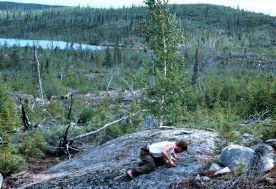The >2.8 Ga Beniah and Bell Lake Formations, Slave Province, Northwest Territories : A Sedimentary Lithofacies Analysis
Clarence Pickett, Masters Thesis.
 Masters thesis under the supervision of Dr. Wulf U. Mueller.
Masters thesis under the supervision of Dr. Wulf U. Mueller.
Project description
The Slave Province, located in the Northwest Territories, hosts a number of Archean shelf-type sedimentary successions (ca. 2.8-2.9 Ga) that lie adjacent to major, north-trending crustal-scale lineaments. These basins contain mineralogically mature quartz-arenites that have formed under specific climatic, hydraulic and tectonic conditions. The sedimentary rocks unconformably overlie >3.0 Ga tonalite-granodiorite basement and layered igneous complexes and are overlain by 2.6-2.7 Ga mafic and felsic volcanic rocks.
The 100 to 1000 m-thick Beniah Formation ( 150 km northeast of Yellowknife, NWT) contains four distinct lithofacies including: 1) the 2-13 m-thick conglomerate (CL), 2) the 10-120 m-thick quartz-arenite (QAL), 3) the 10-16-m-thick sandstone-siltstone (SaSL) and 4) the 5-13 m-thick siltstone-sandstone (SiSL) lithofacies. The conglomerate lithofacies is subdivided into the quartz-pebble conglomerate (QPSL) and sedimentary breccia sublithofacies (SBSL). The siltstone-sandstone lithofacies contains both the wavy- to planar-bedded (WPSL) and iron-formation (IFSL) sublithofacies. Minor volcanic and volcaniclastic rocks locally indicate conformable depositional contacts with the underlying sedimentary rocks and represent the upper-most stratigraphic level of the Beniah Formation.
The ubiquitous tabular geometry of the lithofacies, the multiform composite cross-strata, bimodal/bipolar paleocurrent patterns and abundance of mudstone drapes strongly support tidal influence for the Beniah Formation with evidence of lesser wave and storm activity. Deposition occurred in a shallow marine estuarine/embayment complex containing: 1) coastal gravel bars within an embayment and along a shoreline (QPSL), 2) local debris flow deposits (SBSL), 3) a series of tidal channels and shoals (SaSL & WPSL), 4) migrating sandwaves along the shoreface (QAL) and 5) heterolithic sediments deposited in a deeper, transitional lower shoreface to offshore setting (WPSL/IFSL & SaSL).
Supplementary data from the Bell Lake Formation ( 45 km north of Yellowknife) revealed three distinct lithofacies: 1) the 2-10 m-thick quartz-arenite, 2) the 1-12 m-thick sandstone-siltstone and 3) the 0.5-30 m-thick iron formation lithofacies. The abundance of parallel laminae and low-angle cross-laminae bounded by thin, extensive tabular beds are characteristic of a coastal depositional setting open to the ocean, providing favourable conditions to form sheet sandstones under the influence of tides, waves and possible storms. Petrography coupled with field evidence advocates an unconformable, rather than intrusive contact between the basement and overlying Bell Lake Formation.
Lithofacies stacking in the Beniah Formation reveals the presence of up to 12 coarsening-upward sequences (10-105 m thick) that begin with a basal SiSL, grading upward into the SaSL and terminating with the QAL or CL. A sharp contact between the QAL (or CL) and the SiSL marks the commencement of a new sequence. The upward-coarsening sequences have been attributed to a combination of eustatic sea level change and tectonic activity. The role of tectonism was significant in the development of the Beniah Formation. The presence of layered intrusions, upward-coarsening sedimentary cycles, the abundance of cross-cutting mafic dykes and contemporaneous volcanism strongly support extension. The proposed model for the Beniah Formation and for similar quartz-arenite sequences throughout the Slave Province (including Bell Lake, Patterson, Brown and Winter lakes) presupposes the presence of an extensive proto-continental crust of tonalite and granodiorite 3.0 billion years ago. Crustal attenuation from extension and rifting allowed for the emplacement of layered igneous complexes. Large crustal-scale faults developed in response to crustal thinning, thus forming topographic lows where sediment accumulated in shallow marine basins. Subsequent episodes of extension resulted in flooding of the basin and the development of upward-coarsening sedimentary cycles. Continued crustal attenuation and break-up of the proto-continent resulted in subaqueous effusive volcanism covering the sedimentary succession at about 2.8 Ga.
The accumulation of the quartz-arenites from the Beniah and Bell Lake formations imply a tropical-like climate due to high CO2 levels and elevated surface temperatures. A more dynamic Earth-Moon system in the Archean combined with a high-energy environment resulted in the development of these extremely quartz-rich sandstones.
Archean quartz-rich sedimentary successions from the Zimbabwe Craton of Africa, the Indian Dharwar Craton and the Superior Province of the Canadian Shield are comparable to the Beniah and Bell Lake formations in both lithology and depositional setting. In addition, episodic rifting has been inferred for each of these areas, thus alluding to the possibility of a major, worldwide tectonic event that transpired 2.8-3.0 billion years ago on parts of the Earth's earliest continental crust.
![]() Résumé francais. Les Formations de Beniah et de Bell Lake de >2,8 Ga, Province des Esclaves, Territoires du Nord-Ouest : Une analyse des lithofaciès sédimentaires.
Résumé francais. Les Formations de Beniah et de Bell Lake de >2,8 Ga, Province des Esclaves, Territoires du Nord-Ouest : Une analyse des lithofaciès sédimentaires.
Question or commentary contact me: pig_mac@hotmail.com.
